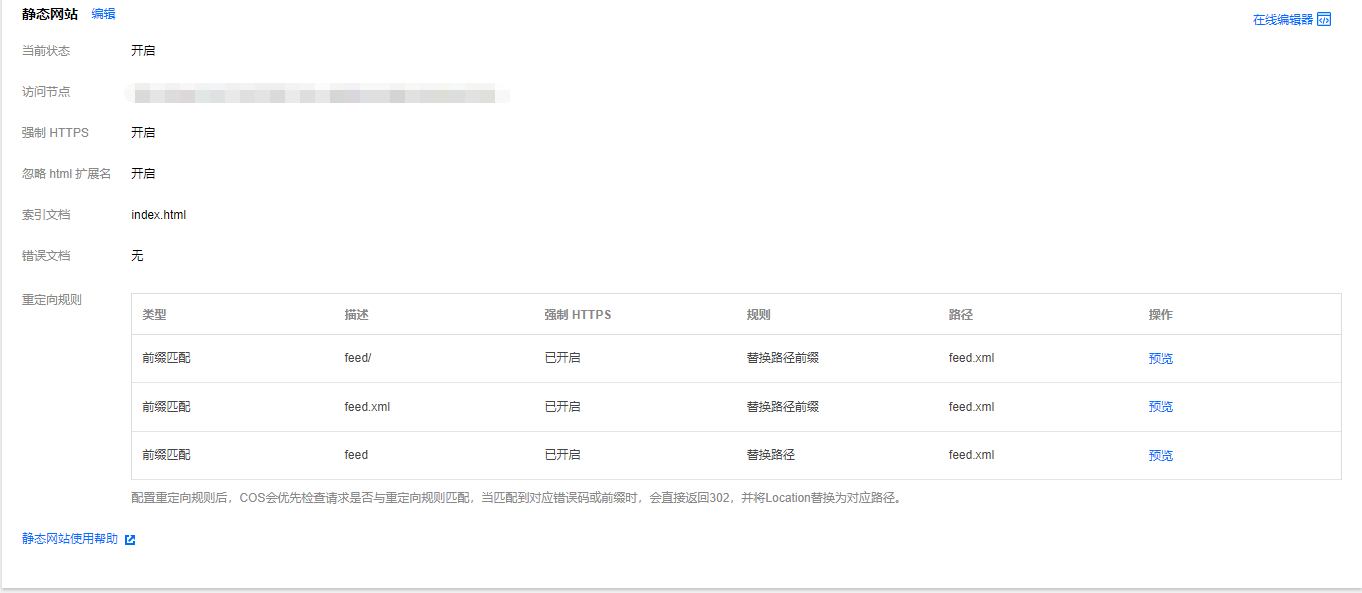2023年05月06日 集成Elog,重新启用COS…
2023-03-30 再次更新部署到虚拟机上,弃用COS。
2022-08-07 再一次开始折腾hexo了,为了省下高昂的服务器费用,为了利用上永久的虚拟主机。 只不过可惜的是虚拟主机不能支持 https,所以无奈使用了COS。 还有一点就是用markdown写文章感觉确实不错,再加上github action加持,hexo用起来感觉也是相当不错的. 而且服务器的话WordPress还要考虑一堆的性能优化问题,静态博客就完全不用担心了。 下面简单记录下hexo的部署配置问题。
Hexo 配置 固定 ID 固定 ID 推荐使用hexo-abbrlink2
1 npm install hexo-abbrlink2 --save
Modify permalink in config.yml file: 1 permalink: posts/:abbrlink/
资源目录 在引用图片时通过路径/images/image.jpg,引入图片资源
Next 配置 创建标签云 默认无标签页,打开链接会404 创建标签页:
1 2 3 4 --- date: 2021-08-04 13:22:27 type: "tags" ---
创建分类页 默认无分类页,打开链接会404 创建分类页:
1 hexo new page categories
1 2 3 4 --- date: 2021-08-04 13:22:33 type: "categories" ---
自定义样式 hexo根目录下的source新增一个_data目录,在该目录下新建styles.styl,这个文件将存放我们自定义的样式,然后在_config.next.yml文件中custom_file_path选项里面将style那一行取消注释。
1 2 3 4 5 6 7 8 9 10 11 custom_file_path: style: source/_data/styles.styl
添加备案号 1 2 3 4 5 footer: beian: enable: true icp: xxxxxx
自动化部署 COS 1 npm install hexo-deployer-cos --save
Options You can configure in _config.yml as follows: 1 2 3 4 5 6 deploy: type: cos secretId: yourSecretId secretKey: yourSecretKey bucket: yourBucket region: yourRegion
For projects that use pipelines, you may not want to expose COS properties in the project file, so we support getting them through environment variables.
1 2 3 4 COS_SECRET_ID=yourSecretId COS_SECRET_KEY=yourSecretKey COS_BUCKET=yourBucket COS_REGION=yourRegion
Environment variables have lower priority than _config.xml configuration
FTPSync Install hexo-deployer-ftpsync. 1 npm install hexo-deployer-ftpsync --save
1 2 3 4 5 6 7 8 9 10 deploy: type: ftpsync host: <host> user: <user> pass: <password> remote: [remote ] port: [port ] ignore: [ignore ] connections: [connections ] verbose: [true |false ]
文章更新时间设置: updated_option
`updated_option` 控制了当 `Front Matter` 中没有指定 `updated` 时,`updated` 如何取值:
`mtime`: 使用文件的最后修改时间。这是从 `Hexo 3.0.0` 开始的默认行为。
`date`: 使用 `date` 作为 `updated` 的值。可被用于 `Git` 工作流之中,因为使用 `Git` 管理站点时,文件的最后修改日期常常会发生改变
`empty`: 直接删除 `updated`。使用这一选项可能会导致大部分主题和插件无法正常工作。 `use_date_for_updated` 选项已经被废弃,将会在下个重大版本发布时去除。请改为使用 `updated_option: ‘date’`。
CDN 缓存刷新 方案一 该方案参考自:https://segmentfault.com/a/1190000039707833

但这个方案存在一个问题,由于我们的静态网站有默认索引页面 `index.html`,而官方提供的这个函数只会刷新对应的文件的 `URL`,而不会刷新索引 `URL`,例如`http://www.bytelife.net/index.html`这个文件,通常我们的请求是`http://www.bytelife.net/`,因此官方的方案针对于静态网站来说不算完美。
优化方案 可以通过简单修改官方的函数来解决这个问题,点击刚刚创建的 `CDN` 缓存刷新函数列表中的函数名称,将 `index.js` 文件内容替换为下面的代码,最后点击右上角的“部署”按钮即可:
1 2 3 4 5 6 7 8 9 10 11 12 13 14 15 16 17 18 19 20 21 22 23 24 25 26 27 28 29 30 31 32 33 34 35 36 37 38 39 40 41 42 43 44 45 46 47 48 49 50 51 52 53 54 55 56 57 58 59 60 61 62 63 64 65 66 'use strict' ;const TimeoutWatcher = require ('./common/TimeoutWatcher' );const CosCdnRefreshTask = require ('./common/CosCdnRefreshTask' );const { getParams, logger, getLogSummary } = require ('./common/utils' );exports .main_handler = async (event, context) => { let runningTask; const watcher = new TimeoutWatcher ({ timeLimit : context.time_limit_in_ms , trigger (error ) { if (runningTask && runningTask.cancelTask ) { runningTask.cancelTask (error); } }, error : new Error ('task is timeout' ), }); logger ({ title : 'param as follow: ' , data : { event }, }); const { secretId, secretKey, token, objects, triggerType, cdnHosts } = getParams (event); logger ({ title : 'param is parsed success' , }); const taskResults = []; const task = new CosCdnRefreshTask ({ secretId, secretKey, token, objects, triggerType, cdnHosts, }); if (watcher.isTimeout ()) { process.nextTick (() => task.cancelTask (watcher.error )); } else { runningTask = task; } const results = await task.runTask (); results.forEach ((item ) => { taskResults.push (item); if (item.params .urls [0 ].lastIndexOf ('/index.html' ) == item.params .urls [0 ].length - 11 ) { taskResults.push (item.substr (0 , item.length - 10 )); } }); watcher.clear (); logger ({ title : 'cos cdn refresh full logs:' , data : taskResults, }); const { status, messages } = getLogSummary ({ name : 'cos cdn refresh' , results : taskResults, }); logger ({ messages : messages.map ((item ) => item.replace (/, /g , '\n' )), }); context.callbackWaitsForEmptyEventLoop = false ; if (status === 'fail' ) { throw messages.join ('; ' ); } else { return messages.join ('; ' ); } };
方案二 该方案参考自:https://blog.xm.mk/posts/fc83/#%E7%BC%93%E5%AD%98%E5%88%B7%E6%96%B0%E8%84%9A%E6%9C%AC
使用腾讯云的 `Python-SDK` 实现,写一个 `Python` 脚本,在部署完成后执行脚本调用 `API` 完成缓存刷新。
在仓库根目录下创建文件 `flush-dns.py`,文件内容如下,将其中的 `https://blog.example.com/` 修改为你的 `CDN` 加速域名。
1 2 3 4 5 6 7 8 9 10 11 12 13 14 15 16 17 18 19 20 21 22 23 24 25 26 27 28 29 30 31 32 33 34 import jsonimport argparsefrom tencentcloud.common import credentialfrom tencentcloud.common.profile.client_profile import ClientProfilefrom tencentcloud.common.profile.http_profile import HttpProfilefrom tencentcloud.common.exception.tencent_cloud_sdk_exception import ( TencentCloudSDKException, ) from tencentcloud.cdn.v20180606 import cdn_client, modelsparser = argparse.ArgumentParser(description='-i <secretId> -k <secretKey>' ) parser.add_argument('-i' , '--secretid' , type =str , required=True , help ='secretId' ) parser.add_argument('-k' , '--secretkey' , type =str , required=True , help ='secretKey' ) args = parser.parse_args() try : cred = credential.Credential(args.secretid,args.secretkey) httpProfile = HttpProfile() httpProfile.endpoint = "cdn.tencentcloudapi.com" clientProfile = ClientProfile() clientProfile.httpProfile = httpProfile client = cdn_client.CdnClient(cred, "" , clientProfile) req = models.PurgePathCacheRequest() params = {"Paths" : ["https://blog.example.com/" ], "FlushType" : "flush" } req.from_json_string(json.dumps(params)) resp = client.PurgePathCache(req) print (resp.to_json_string()) except TencentCloudSDKException as err: print (err)
创建完脚本后,需要在工作流中调用,配置如下:
1 2 3 4 5 6 7 - name: Flush CDN env: SECRET_ID: ${{ secrets.SecretId }} SECRET_KEY: ${{ secrets.SecretKey }} run: | pip install --upgrade tencentcloud-sdk-python python flush-dns.py -i $SECRET_ID -k $SECRET_KEY
COS 配置 重定向规则 由于当时用WordPress时提供的rss订阅地址为/feed/,现在的订阅地址/feed.xml,为了兼容WordPress时订阅地址,需要做重定向规则配置:

